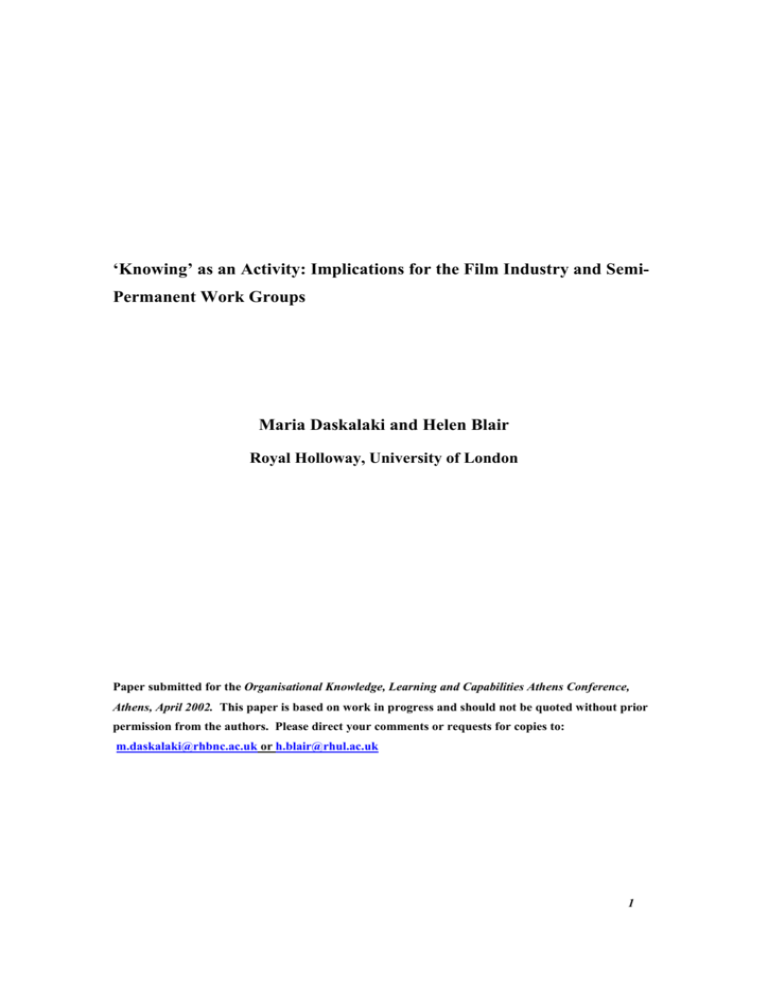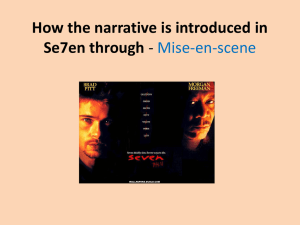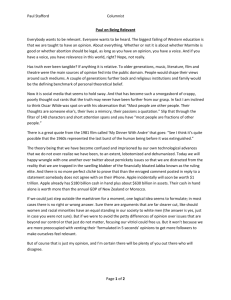Implications for the Film Industry and Semi
advertisement

‘Knowing’ as an Activity: Implications for the Film Industry and SemiPermanent Work Groups Maria Daskalaki and Helen Blair Royal Holloway, University of London Paper submitted for the Organisational Knowledge, Learning and Capabilities Athens Conference, Athens, April 2002. This paper is based on work in progress and should not be quoted without prior permission from the authors. Please direct your comments or requests for copies to: m.daskalaki@rhbnc.ac.uk or h.blair@rhul.ac.uk 1 Introduction The central concern of this paper is to provide a theoretical explanation of the nature of knowing in an industry organized around a project-based form of work, the film industry. Particularly, it asks how knowledge of the work process, culture and rules of film production are gained and stored by both individuals and semipermanent work groups (SPWGs) (Blair, 2000) and then contributed for a short time to organisations. 1. Semi-permanent Work Groups and Filmmaking This section describes some of the characteristics of the SPWGs. The semipermanent work group defines an informal work unit prevalent in the film industry which comprises a relatively stable membership who move as a collective unit from project to project. Goodman and Goodman consider a temporary system as a ‘set of diversely skilled people working together on a complex task over a limited period of time’ (Goodman and Goodman, 1972: 494). Much management theory, and theories of knowledge in that sphere, assume the notion of organizational permanence (or at least its desirability). These approaches assumes a very rigid conceptualization of the term ‘knowledge’, attaching a far greater importance to the impact of geographical boundaries and permanent structures on the process of learning. Contrastingly however, project based organizations assemble resources (financial, human and technical) on a one-off basis and with the explicit intention that those resources will be dispersed on completion of the task (DeFillippi and Arthur, 1998; Jones 1996). As a complex, ambiguous and uncertain process, the 2 knowledge of film freelancers is key to filmmaking (Blair, 2001a). Yet, as a consequence of temporary organization, the importance of organizational learning is much reduced and notions of knowledge resources providing long-term competitive advantage for a particular unit of capital are largely redundant (Corrado et al., 2001). A semi-permanent work group comprises a number of individuals (usually those required to form a department) who work together on an almost permanent basis. The group will move from job to job in its entirety with the members remaining the same. Therefore, ongoing contacts exist between each member of the group but also significantly between the head of department (who supplies employment opportunities) and group members. Although these groups may remain stable for a number of years, their configuration is not career-long as individuals may leave (for career progression purposes, for example) or may be expelled (if, for example, performance is not satisfactory). The freelance-dominated labour market is characterised by uncertainty and a potentially turbulent environment. The assembly of established work groups could be viewed as a mechanism to reduce the uncertainty of getting work on the part of employees and of potentially unsuccessful working relationships on the part of both capital and labour. Unsuccessful working relationships may affect both the work process and the final product and therefore capital avoids the risk of bringing in a group of ‘strangers’ to work together. Failing work relationships may also affect the reputations of the individuals involved and the head of department associated with those people, and so they tend also to be avoided by labour. Working with people known to oneself should facilitate a more effective, less stressful working relationship. 3 Examples of SPGWs: Three of the departments on the case film1 could be described as semi permanent work groups; camera, sound and assistant directors departments. The camera department is the most complex example of semi permanent groups evidenced on the case film. As can be seen in Figure 1, the work group is comprised of the director of photography (DOP - head of department), focus puller, grip, gaffer and clapper/loader. Prior to joining the present group configuration the focus puller and clapper/loader had an established work relationship. When the focus puller joined the above group, he brought the clapper/loader with him. Similarly the grip had worked with both the focus puller and clapper/loader prior to joining the group. Figure 1 illustrates the longevity of the relationships between members of the group and so it can be seen that the focus puller, and clapper/loader have completed between eight and ten jobs with the DOP, with the grip having worked with him over some three years. That principle can also be seen to apply with the gaffer who engages in repeated working relationships with the same electricians. This group therefore moves from film to film with that combination of personnel. Since the case film, this semi permanent work group have completed at least one other project together. 1 The ‘case film’ here refers to a case study by one of the authors; it has been documented elsewhere as ‘Teen Comedy’. 4 Focus Puller 15 jobs 8-10 jobs 6 jobs Generator Operator 15 jobs Clapper/ loader DOP 20 jobs Gaffer 8-10 jobs 8 jobs 100+ Best Boy 6 jobs Electrician 8 years 3 years 2 years 6 jobs Electrician Grip Figure 1. Pattern of Working Relationships in the Camera/Electrical Department The assistant director department is populated by the head of department (the first) and two assistants. Of the two assistants, the second had completed three jobs with the head and the third assistant, two (see Figure 2 below). Having joined the group after the second, the third had also undertaken two jobs with the third assistant. Since the case film that unit have gone on to complete another job together. First Assistant Director 3 jobs 2 jobs 2 jobs Second Assistant Director Third Assistant Director Figure 2. Pattern of Working Relationships in the Assistant Director Department 5 In the sound department (Figure 3), having been the sound mixer’s trainee, the boom operator has worked for him for the past nine years. This established relationship therefore came into being through the traineeship and then an opportunity at the next level (boom operator) became available which the present operator secured. From that time the boom swinger has worked on an ongoing basis with the mixer. Sound Mixer 9 years Boom Operator Figure 3. Pattern of Working Relationships in the Sound Department These inter-relationships give some indication of the established, long-term nature of the groups. Their ‘permanent’ status can also be evidenced in the manner in which members of the group view their relationship to the group and to their head of department in particular (as the key employment supplier). One employee noted, regarding not having found work since involvement in the case film, that: “it hasn’t bothered me finishing [the case film] ... we had nothing definite. I mean I tend to work with [the head of department] more or less permanently these days.” Stephen Significantly, this interviewee uses the word ‘we’, inferring identification with a pre-existing group of people and their collective employment prospects. He also states that that head of department is more or less his permanent employer. Going on, he says: 6 “… we work, within our group people work together quite [a lot] … that might be seen as a little more unusual. People tend to work with people they know as much as they can. Whether we’re usual in so much as having worked with [the head of department] for quite a few films I don’t know” Again this infers a notion of permanency which, although the interviewee indicates some reservations as to their typicality, is taken up by other case film employees: “As I work with [the head of department] a lot … he gets the job and (pause) and, and he tells production he wants me to do it” John and “I'm in with this team and we don't stop working and it is very secure at the moment.” Susan Two reasons can be offered at this point for the existence of semi permanent work groups within departmental boundaries. The first reason is functional, in as much as film production brings together a range of discrete technical and creative skills which lead to departments being comprised of distinct skill groups. The camera and sound departments perform tasks that require different skills, for example. As each department is quite distinct in skill demarcation, the formation of semi permanent work groups offers considerable benefits to task performance and role fulfillment. The second reason for configuring groups around departments is operational and relates to the recruitment and selection process. As heads of department are responsible for recruiting and selecting staff for their department only, any ongoing relationships between the head of department his or her staff will take place within that departmental boundary. As a result of these two factors semi permanent work groups are based around departmental boundaries, and as will be shown in the following section, departmental structures. Additionally, 7 employment security and other benefits raise issues of expectancy (that the head of department will as a group member do a job and that the group member will respond positively when asked) and dependency. This paper suggests that the ‘storage units’ for the industry-wide norms, culture and rules are the individuals comprising each project and the semi-permanent work groups of which they are members. As membership of SPWGs remains fairly consistent over a series of projects, a group memory exists consisting of both previous individual and collective experiences. However, as the combinations of individuals and groups vary on each film project, knowledge is both socially distributed within the SPWGs and spatially distributed throughout the industry. The potential for knowledge to be ‘lost’ is considerable and so the continued existence of SPWGs from project to project assists in the dissemination, maintenance and re-negotiation of various forms of industry knowledge. The paper will therefore consider the role of SPWGs in the maintenance of industry knowledge and their contribution to the operation of the project organizations. 2. Knowing and Cognitive Processes: Socially Distributed Activities This part of the paper focuses on the cognitive functioning of SPWG participants and the way they process their cognitive scripts and routines within diverse activity contexts. We suggest that freelancers in the film industry participate in a collaborative environment where the exchange and sharing of knowledge and meaning are not only encouraged but also considered crucial for both the initiation and completion of projects. It is suggested that within these contexts, members experience high levels of uncertainty, ambiguity and mistrust (DeFillippi and Arthur, 1998; Blair, 2001b). Therefore the formation of enduring teams that conduct an activity in a temporary organisation (e.g. undertaking,creating and 8 producing the hair and make-up effects art design) is an attempt to reduce uncertainty and relationship ambiguity based on a culture of high trust. These cultures can be viewed as ‘systems of enduring socially agreed-on meanings that guide behaviour’ (Berger and Luckman, 1981) the study of which can offer a better understanding of how SPWGs ‘behave’ (use accumulated experiences) and ‘learn’. Finnely and Mitroff (1980) refer to schemata and scripts as ‘consensual’ tools, shared by project members. Schemata are considered to be cognitive structures which are used in organisations for the analysis and communication of information; moreover, scripts can become carriers of socially constructed meaning or ‘relatively predetermined and stereotyped sequences of action which come into play by particular and well-recognised cues or circumstances which we acquire knowledge through the process of socialisation’ (Mangham, 1978). This enables patent reporting relationships and clarity of information flow directions. Following this, project cognitive structures are expected to be ‘socially shared’ and project members ‘co-implicated’ to each others’ actions (Star, 1992). Thus their consensual cognitive schemata are exchanged and reshaped by their interaction in practice. Therefore, learning and knowledge are positioned in neither individual nor in a social domain but are thought of as shared cognitive structures and relationally developed meanings that are ‘situated’ (within teams) and ‘distributed’ (within networks) not in a defined organisational space but in a boundaryless ‘activity system’. This has clear application in the film industry context where production organisations are not permanent and teams combine knowledge resources on individual projects and may subsequently pass knowledge to network contacts or work with different teams on future projects. 9 Activity theory according to Blackler (1995) has its origins in the Marxian approach of Vygotsky (1978) according to which social experiences shape consciousness (instead of human consciousness determining social being). Contemporary approaches emphasise the collective nature of knowing concentrating on the processes that people develop shared conceptions of their activities (see Brown et al., 1989 and Lave and Wegner, 1991) and the relationships that exist between collective interpretations of activities and the socio-cognitive and material resources through which these interpretations are enacted (Hutchins, 1983 and Engestrom, 1987; 1993, in Blackler, 1995). According to these approaches, learning is a non-individualistic process and an active, community-based social practice which involves participation, activity and negotiation of meaning (Lave and Wagner, 1991). Therefore, learning cannot be divided into individual and organisational since it can only take place in a participative, social context, where individuals act and communicate their own personal ‘meanings’. Thus, knowledge can be seen as a form of ‘praxis’ – from the Greek word ‘pratto’ that means engage in an activity within a context – during which individuals become involved in a dynamic interdependent exchange of information and experiences. This implies that knowing – rather than knowledge becomes a dynamic activity that is constantly reshaped within activity spaces substituting the concept of ‘knowledge’ and the fruitless dichotomy between knowledge and learning (Blackler, 1995). ‘Activity spaces’ in this context are considered to be complex patterns of practice that develop over time as culturally situated and socially distributed phenomenon (Blackler et al., 2000). The film industry, we suggest, captures the general trend in work organisations of activity systems ‘becoming more complex and interdependent, objects of activity more abstract and emergent, and communities [or ‘spaces’] of activity more transient’ (Blackler et al., 2000:294). Film 10 production consists of groups of practices within occupational teams (which form individual departments such as camera, sound, art etc.) and practices between each of these teams to enable the production of a complex and unique product. The high degree of interdependency existing between the activities of film production, combining as they do in a single, final product (Blair, 2001b) creates high levels of interdependency between departments. This ambiguous and complex activity, has for the past 40 years been conducted in temporary organisations, with organisational structures and resources being constructed and assembled on a recurrent but temporal basis (DeFillipi and Arthur, 1998). Within this transient context the existence of SPWGs provide a site for both the retention and distribution of the industry culture, knowledge and routines that are reproduced each time a film project is enacted. 3. Semi-permanent Work Groups: Activity Systems and Filmmaking Viewing knowledge (or rather knowing) and learning as activities (see Blackler, 1995) could facilitate our examination of whether and how SPWGs in the film industry retain and create long lasting organisational routines, build trust and develop organisational capabilities. Therefore, the paper examines film production and the individuals involved with it as a constellation of ‘knowledge-based systems’ (Tsoukas, 1996). Knowledge, here, refers to an emergent and distributed social practice; further, systems (or distributed organisational units) are analysed as ‘activity networks’ (Blackler et al., 2000), i.e., as overlapping communities of activity the members of which ‘recognise shared work priorities, work with a common cognitive and technological infrastructure, and support each other’s activity’ (Blackler et al., 2000: 282) towards an emergent object. This object, the product of collective expertise and co-operative interrelations, is the film. 11 This paper, by focusing on the interpersonal distribution of knowledge within the film industry, discusses the ‘distributed’ qualities of learning and the relational character of professional identities within SPWGs and their activities. The concept of activity, as rightly stated by Blackler (1993), is compatible with the notion of ‘frame’ (Goffman, 1974), ‘social worlds’ (Levi-Strauss, 1978) or ‘habitus’ (Bourdieu, 1977), with activity theory (AT) focusing more on the interpersonal relations and the network connections present within overlapping systems that mediate processes and interactions within the group. Moreover, the film (outcome of this interrelationality) should not be thought as the goal of film production; it is not a conscious, short-lived and isolated aim of individual actions; rather, it is the object of collaborative activity systems that encompass embodied knowledge and mediated presence. Consequently, activity theory and its focus on mediated interactions between individuals and their interpretative contexts provide a very useful tool for studying filmmaking as a social practice. Mediation, in this context, refers to the integration of individual actors, the social contexts in which they belong and their shared interests. This integration is facilitated by ‘structuring mechanisms’ such as roles, division of labour and rules tacitly shared by all participants (Engestrom, 1993). Yet, ‘distributed meaning provides a contextually located rationale that permits different potentially idiosyncratic patterns of strategic action to emerge in different contexts’ (Jarzabkowski, 2001:22-3). Furthermore, the interrelated nature of various agents’ actions and their co-dependency but, at the same time, the blurred boundaries and potentially conflicting individual and group interests give rise to tensions and potential conflict within and between teams. This tension can be considered the outcome of the co-presence of various activity systems organized around sometimes, competing actions and differing interests (for example whole product of the project team and SPWG’s work on that project). This variety of activity systems that emerges due to the division of labour (Leont’ev, 1978; 1981) 12 observed in the process of filmmaking (see also Blair, 2001a) can be overcome through ‘attachment to work groups and networks of contacts …[which becomes] the primary conduit for training and learning opportunities (Blair, 2001a). Thus, we suggest that tensions between groups can be exacerbated as groups close in on themselves and look inwards during inter-departmental conflict. Nevertheless, initial research on activity systems and knowledge focused on organisations that are ‘permanent’ and ‘integrated’ systems with a geographical and social space clearly defined and historically construed. This paper suggests testing this theoretical position in the absence of organisational boundaries formalized social activities and institutional codes to support and ‘contain’ a databank of knowledge. We support that knowledge in project-based teams is geographically and temporally ‘distributed’ (see also Blair 2001b: notion of ‘distributed autonomy’) between SPWGs who achieve a task the quality of which is highly dependent the interdependence of their activities. Therefore ‘strategic advantage’ or ‘organisational capabilities’ of the teams are both socially and topographically dispersed in a space that differs from the traditional organisational spaces. Its semi-permanent nature and its spatial and temporal configuration become determining factors of the members’ activities, knowledge structures & systems as well as their subjectivities and inter-relationships. Therefore knowing is embedded in participants-in-interaction and their strong relational ties built based on trust – an activity that may counter the instability and uncertainty of the film production process. By participants-in-interaction we define an alternative spatial context within which teams collectively accumulate experiences and knowledge; knowing therefore in these environments becomes a dynamic activity reshaped within different activity contexts, in this case of different film productions. Thus, the spatiality of the activity gains secondary importance in contrast to its inter-relational aspect which becomes the primary 13 ‘field’ of knowing for each interacting resource group. By ‘inter-relational’ here we refer to the dynamics of recurrent interactions that develop between specific individuals (e.g. director-editor, director-cinematographer, director-production designer or director-composer; see Corrado et al., 2001) during semi-permanent collaborative activities. In addition, as suggested above, the interdependence of these teams does create a new form of spatiality by utilizing looser recurrent groupings to ensure relational continuity. This new space created is held together through the invisible connections that exist for each team member and their network. Meaning therefore within these networks is ‘mutually constituted in relations between activity systems and persons acting and has a relational character’ (Lave, 1993). Thus, sensemaking and learning are two processes that require dialogue and open communication channels between potential or at present team members. In turn, this demands for individuals to come together and collectively create new meaning and new routines or negotiate and re-establish old ones. This is what Dixon (1994) called ‘public map making’ according to which tacit collective meaning structures – a kind of defensive routines that have become tacit and part of the previous project’s collective meaning structures- should be placed back ‘into the accessible meaning of the individuals, where [they] can be challenged, tested and altered’ (Dixon, 1994). This will allow the reconstitution of the team around a different project (another production) that may require alternative cognitive structures and will allow the creation of new knowledge and capabilities to emerge for the team in recurrent collaborative activity. However, in order to achieve that – a form of Lave and Wegner (1981) ‘legitimate peripheral participation’- members of the team ought to critically examine their knowledge structures and be willing to share their previously acquired experience with the team members, i.e. view film making as a shared experience. This is a 14 situation that could also potentially evoke contradictions, uncertainty and conflict2 between collaborators unless their activity system integrates ‘the subject, the object and the instrument (material tools as well as sign and symbols) into a unified whole’ (Engestrom, 1993). According to Engestrom, activity systems are built based on the relations between agents (like actors, producers, directors etc.), the community of which they are members (industry members and their interrelated activities) and the conception people have about their activities. These relations necessarily also involve the mediated role of technologies or technoactors or ‘actants’ (Latour, 1987) (cameras, photography, other equipment etc), language (industry jargon) and implicit and explicit social rules, systems and division of labour prevalent in their communities of practice. In 2000, Engestrom expanded his activity systems theory, that emerged from his studies of the Finish health care system, and devised the term ‘knotworking’ in an attempt to describe a new form of work organisation. He suggested that the notion of ‘knot’ describes a ‘rapidly pulsating, distributed and partially improvised orchestration of collaborative performance between otherwise loosely connected actors and activity systems. A movement of tying, untying together seemingly separate threads of activity characterizes knotworking’ (Engestrom, 2000: 971). By adopting this term in the area of filmmaking, we could describe the relationships that develop around SPWGs. Although, however, for Engestrom (2000) ‘knotworking’ has no clear deadline or a stable center of activities, SPWGs in the film industry allow for co-configuration work to take place due to the repeated interactions that co-implicate the same or interrelated networks of individual, teams or institutions. So, instead of taking as level of analysis the task 2 These are also addressed in following sections of this paper. 15 or the product (object of the activity) like Engestrom, we focus on the actors and the process of knowing. As a result of this, SPWGs in filmmaking constitute dispersed ‘knotworking systems’ the activities of which redefine and reconstitute the object of their collaboration each time they form a team or a group3. The ties and inter-subjectivities that such systems entail result in an alternative organisational space which is continuously recreated every time teams come together. Similarly, when these teams are dismantled, their knowledge is redistributed in the social-communicative environment in which they operate (‘industry spaces’). However, these participative environments inherently entail situations of uncertainty, ambiguity and conflict. These tensions and conflicts between activity systems according to Engestrom (1993) are the result of the division of labour in capitalist society and commodification of activity. This in the situation of the film industry is intensified by the uncertainty regarding the success of the product. It appears therefore that unity of teams in both a horizontal and vertical manner could facilitate decision-making and communication. For Engestrom (1993) this becomes possible through activity systems theory which emphasizes collaborative accounts of knowing and discourages the separation of the individual from the collective and the social from the technical. Furthermore according to Blair (2001a) ‘pre-existing connections and linkages are explicitly drawn upon in a project context to minimize the uncertainty and risk of one-off transactions in key resource areas’. Similarly ‘it is through their collective determination and skill, both in their actions and their language, that participants enact particular frames (i.e. impose conceptions of their activities on situations they believe appropriate) and maintain a (seemingly) smooth flow of events’ (Blackler, 1995). However, this implies that 3 This is because filmmaking is a bounded experience with deadlines and a given temporal frame of existence. 16 inequalities of power don’t interfere with the working relationships and enactment capabilities of the team. The following section summarises the formal structure of film production and SPWGs demonstrating the hierarchical organisation of the industry. This, we suggest, raises issues of power and division of labour within activity systems and signifies the contested nature of knowing within work organisations. 4. Hierarchical Organisation of Film Production: Implications for Activity Systems In contradiction to much of the popular, prescriptive literature surrounding the management of creative employees, the co-ordination of film production is highly hierarchical (Blair 2001a). The case production involved a crew of some sixty (a relatively small number), yet the number of layers between junior and senior employees is considerable. For example, between the clapper/ loader (a junior member of the camera department) and the director there are four layers (see Figure 4 to illustrate). Director Production Manager Director of Photography Grip Focus Puller Gaffer Clapper/loader Trainee Camera Department Figure 4. Formal Structure of the Camera Department 17 The departmental hierarchies evidenced in the case production involved strict task demarcation and clearly defined reporting relationships between different levels of the organisation. Each lower grade is supervised by the one immediately above, with the clapper loader describing his job as follows: “Well its basically its assisting the focus puller. Obviously the cameraman, but you’re mainly assisting the focus puller. You come in and you mark the clapper boards up with the correct date, make sure the film is loaded in the magazines which means the film would be in rolls in a can. You put the film from the cans into the magazines and the magazines are the items which go on the camera, its like a big metal case with film that goes on the camera. So you would check that you’ve got the right stock, film stock … basically go on the floor and start off and you listen to what, the cameraman wants a change of filters you would sort of automatically go to, or change lenses, you would go to the box to get’em for the focus puller. Once you get the lens to them, where the camera is, you’d pass it over to the focus puller. He would then put it on the camera. You’ll take the lens that was on the camera back to the lens box, put it in. You make sure that the lens is clean before you give it to the focus puller and if its not clean either you would clean it yourself or you would say to the focus puller ‘Oh there’s a smudge on the front or the back’. And that’s the same with filters, you would do that with filters.” [our emphasis] Allan It is also illustrated through the view of one camera department member, concerning his career progression: “ the next progression obviously is going to stay focus pulling for quite a number of years but then hopefully move up to camera operator and maybe one day in the distant future cameraman. But you know … I take one step at a time.” In the instance of the camera department therefore each grade completes tasks directly for the next grade. A similar system was observed in all departments, where tasks undertaken at a ‘lower’ level directly enabled those further up the 18 hierarchy to complete their tasks. In the costume department, the costume assistant would wash and ready clothes for the next days shooting so that the dresser/wardrobe supervisor could dress the actors/esses the following day. Supervision of workers also infers a relatively high degree of control over tasks by more senior members of departments. For example, on being introduced to and talked through the art departments work, the assistant art director explained that she never put anything on a drawing without the prior decision of the art director or production designer. This applied to items as seemingly insignificant as the style of a door handle. The hierarchical organisation of film production is discussed in greater depth in similar work (Blair, 2001a) as it is a complex issue. It is, for example, reinforced by a large number of commonly held assumptions and rules which are instilled in junior members of staff as the work their way through the grades and based upon skill levels, length of attachment to a group and task allocation. The purpose in briefly raising the issue here is to characterise the nature of work groups. Nevertheless, following Blair (2001a), a clear hierarchy in co-ordinating and controlling the vertical division of labour is observed in the organisation of work in the film industry that however does not hinder training and learning. Similarly, though interactional asymmetries may arise within the context of interaction, this does not necessarily mean domination of one particular group over another during social encounters (Daskalaki, 2000). This is in accordance with Foucault’s (1980) notion of ‘reversible’ qualities of power that suggests that freedom (or liberty) is not an institutional structure or a state of being but a practice (Sawicki, 1998). Accordingly, we view film production as form of social interaction, a mode of action and a systemic activity. ‘In other words, interactive communication and cooperation processes have a circular, self-organising nature’ (Albertini, 1999:113). 19 Fox’s (2000) valuable contribution discusses issues of power, action and learning within ‘Communities of Practice’ (COP) by drawing connection between ActorNetwork Theory (ANT) and late Foucauldian views on power. Despite the fact that there is an ideological focus on ‘concrete practices’, the latter two and especially Foucault’s (1984) later work, draw ‘upon the self which acts forcefully upon itself’ and may resist itself (Fox, 2000). Power, in this respect, is viewed as ‘a form of action or relation between people which is negotiated in interaction and is never fixed’ (Mills, 1997:39). So, we suggest that it is this notion of force and its implications for subjectivity, action and network relationships that should be further analysed when SPWGs and their interrelated activities are studied. Conclusion This is a work in progress that attempted to introduce a theoretical framework that will facilitate and expand the analysis of the activities of SPWGs in the creative industries. In terms of the nature of learning, we have suggested that this is a social activity. Given that in the film, and many other creative industries, organisations are not permanent, it is important to ask how individual members gain and store knowledge in that transient environment. We have also suggested in this paper that the ongoing work groups (called Semi-Permanent Work Groups here) are the main ‘site’ for the transmission of work and social norms as well as technical know-how. The paper adopted a version of Activity Theory, or culturalhistorical activity theory. This very general framework for conceptualising human activities provided an alternative formulation as to how individuals and teams learn and how SPWGs survive and evolve. Consequently, in contrast to other theories of learning (e.g. Nonaka and Taleuchi, 1995), we suggested that film production entails periods of tension and conflict that become key features in the negotiation of meaning and the cycle of knowing within and between various activity contexts. 20 References Albertini, S. (1999) Networking and Division of Labour – The Case of Industrial Districts in the North-East of Italy, Human Systems Management, vol. 18(2): 107-115. Berger, P. and Luckmann,T. (1966) The Social Construction of Reality: A treatise in the Sociology of Knowledge. Harmondsworth: Penguin. Blackler, F. (1993) Knowledge and the Theory of Organisations: Organisations as Activity Systems and the Reframing of Management, Journal of Management Studies, vol. 30: 865-884. Blackler, F. (1995) Knowledge, Knowledge Work and Organisations: An Overview and Interpretation, Organization Studies, 16, 1021-1046. Blackler, F., Crump, N. and McDonald, S. (2000) Organizing Processes in Complex Network Activities, Organization, 7(2): 277-300. Blair, H. (2000) Working in Film: employment in a project-based sector' Personnel Review, Vol. 30, 2, 170-185. Blair, H. (2001a) Institutional Maintenance and Carriers: the role of hierarchy and interpersonal networks in project based organisations', Regional Studies,(forthcoming). Blair (2001b) Responsible Autonomy in Conditions of Uncertainty: the case of film production’ 19th International Labour Process Conference, Royal Holloway (University of London). 26th-28th March. Bourdieu, P. (1977). Outline of a Theory of Practice, trans R. Nice. Cambridge: Cambridge University Press. (First published in French, 1973.) Brown, J.S., Collins, A. & Duguid, S. (1989). Situated Cognition and the Culture of Learning, Educational Researcher, 18(1), 32-42. Corrado, R. Ferriani, S. and Boschetti, C. (2001)’Managing Knowledge and Resources in Highly Creative Contexts: New Insights from the US Movie Industry’, paper presented in the British Academy of Management Conference, Cardiff. Daskalaki, M. (2000) Induction Programmes in the Age of ‘Corporate Culture’: The ‘Sophisticated Subject’, Business and Professional Ethics Journal, 19 (3&4): 199-231. DeFillipi, R. J. and Arthur, M. B. (1998) Paradox in Project-Based Enterprise: The Case of Film Making, California Management Review, vol. 40(2), Winter, 125139. Engestrom, Y. (1987) Learning by Expanding: An Activity Theoretical Approach to Developmental Research. Helsinki: Orienta-Konsultit. 21 Engestrom, Y. (1991) ‘Developmental Work Research: Reconstructing Expertise through Expansive Learning’, in M. Nurminen and G. Weir (Eds.) Human Jobs and Computer Interfaces. Amsterdam: North Holland, pp. 265-290. Engestrom, Y. (1993) ‘Work as a Testbed of Activity Theory’, in S. Chaiklin and J..Lave (Eds.) Understanding Practice: Perspectives on Activity and Context. Cambridge University Press, pp. 65-103. Engestrom, Y. (2000) Activity Theory as a Framework for Analysing and Redesigning Work, Ergonomics, July, 7: 960-977. Foucault, M. (1980) History of Sexuality. N.Y.: Vintage. Foucault, M. (1980) Power/Knowledge: Selected Interviews and Other Writings 19721977. Hemel Hampstead: Harvester Wheatsheaf. Fox, S. (2000) Communities of Practice, Foucault and Actor-Network Theory, Journal of Management Studies, September, 37(6): 853-868. Goffman, I. (1974) Frame Analysis: An Essay on the Organization of Experience. New York: Harper & Row. Goodman, L. P. and Goodman, Jones, R.A (1972) Theatre as a Temporary System, California Management Review, 15(2): 103-108. Hutchins, E. (1983) ‘Understanding Micronesian Navigation’, in D. Gentner and A. S Stevens (Eds.) Mental Models. Hillsdale, N.J.L Erlbaum. Jarzabkowski, P. (2001) Strategy as Social Practice: An Activity Theory Perspective, The Research Institute, Research Paper Series, Aston Business School. Latour, B. (1987) Science in Action. Cambridge: Harvard University Press. Lave, J. (1993) ‘The Practice of Learning’, in S. Chaiklin and J..Lave (Eds.) Understanding Practice: Perspectives on Activity and Context. Cambridge University Press, pp. 3-32. Lave, J. and Wegner, E. (1991) Situated Learning: Legitimate Peripheral Participation. Cambridge CUP. Leont'ev, A. N. (1978) Activity, Consciousness, Personality. Englewood Cliffs, NJ, Prentice Hall. Leontiev, A.N. (1981) ‘The problem of activity in psychology’. In Wertsch, J. (ed), The concept of activity in Soviet psychology. Armonk, NY: Sharpe. Mills, S. (1997) Discourse. London: Routledge. Sawicki, J. (1998) ‘Feminism, Foucault and Subjects of Power and Freedom’, in J. Moss (Ed.) The Later Foucault. London: Sage, pp. 93-107. 22 Star, S. (1992) The Trojan Door: Organisations, Work and the ‘Open Black Box’, Systems Practice, 5, 395-410. Strauss-Levi, A. (1978) A Social World Perspective, Studies in Symbolic Interaction, 1: 119- 128. Tsoukas, H. (1996) The Firm as a Distributed Knowledge System: A Constructionist Approach, Strategic Management Journal, 17: 11-25. Vygotsky, L.S. (1978). Mind in Society. Cambridge, MA: Harvard University Press. 23







